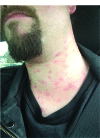Assessment of Hospital Emergency Department Response to Potentially Infectious Diseases Using Unannounced Mystery Patient Drills - New York City, 2016
- PMID: 28910268
- PMCID: PMC5657916
- DOI: 10.15585/mmwr.mm6636a2
Assessment of Hospital Emergency Department Response to Potentially Infectious Diseases Using Unannounced Mystery Patient Drills - New York City, 2016
Abstract
Recent outbreaks of infectious diseases have revealed significant health care system vulnerabilities and highlighted the importance of rapid recognition and isolation of patients with potentially severe infectious diseases. During December 2015-May 2016, a series of unannounced "mystery patient drills" was carried out to assess New York City Emergency Departments' (EDs) abilities to identify and respond to patients with communicable diseases of public health concern. Drill scenarios presented a patient reporting signs or symptoms and travel history consistent with possible measles or Middle East Respiratory Syndrome (MERS). Evaluators captured key infection control performance measures, including time to patient masking and isolation. Ninety-five drills (53 measles and 42 MERS) were conducted in 49 EDs with patients masked and isolated in 78% of drills. Median time from entry to masking was 1.5 minutes (range = 0-47 minutes) and from entry to isolation was 8.5 minutes (range = 1-57). Hospitals varied in their ability to identify potentially infectious patients and implement recommended infection control measures in a timely manner. Drill findings were used to inform hospital improvement planning to more rapidly and consistently identify and isolate patients with a potentially highly infectious disease.
Conflict of interest statement
Figures


Comment in
-
Commentary.Ann Emerg Med. 2018 Jan;71(1):42-43. doi: 10.1016/j.annemergmed.2017.11.019. Ann Emerg Med. 2018. PMID: 29268998 Free PMC article. No abstract available.
References
-
- US Department of Homeland Security. Homeland security exercise and evaluation program (HSEEP), April 2013. Washington, DC: US Department of Homeland Security; 2013. https://www.fema.gov/media-library-data/20130726-1914-25045-8890/hseep_a...
-
- New York City Department of Health and Mental Hygiene. NYC DOHMH guidance document for development of protocols for management of patients presenting to hospital emergency departments and clinics with potentially communicable diseases of public health concern. New York City, NY: New York City Department of Health and Mental Hygiene; October 2014. http://www.programinfosite.com/oepr/files/2014/10/Guidance-document-fina...
-
- Foote MK, Daver R, Quinn C. Lessons learned from the use of “mystery patient” drills to assess hospital Ebola preparedness in New York City, 2014–2015. Health Secur. In press 2017. - PubMed
MeSH terms
LinkOut - more resources
Full Text Sources
Other Literature Sources
Medical

